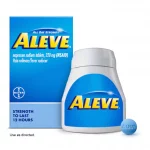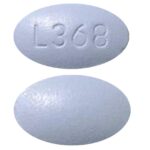How Many Aleve (Naproxen) Can I Take?

Aleve is a brand of naproxen, a nonsteroidal anti-inflammatory drug (NSAID). Naproxen works by reducing hormones that cause inflammation and pain in the body. Aleve is used to temporarily relieve minor aches and pains due to arthritis, muscular aches, backache, menstrual cramps, headache, toothache, and the common cold. Aleve is also used to temporarily reduce fever.
Naproxen was first released to the prescription drug market in 1976 under the name Naprosyn. In 1980, its counterpart salt, naproxen sodium was released for prescription use only under the name Anaprox. In June of 1994, the FDA approved naproxen’s use for an over-the-counter drug in low doses, this new drug was advertised as Aleve and marketed by Bayer HealthCare. Aleve may also be used for purposes not listed in this medication guide.
How many 220 mg Aleve can I take?
The amount of Aleve you can take and how often you should take it depends on :
• your age
• the condition being treated
• how severe your condition is
• other medical conditions you have
• how you react to the first dose and naproxen form
Dosage forms and strengths
Generic: Naproxen
• Form: immediate-release oral tablet
• Strengths: 250 mg, 375 mg, 500 mg
• Form: delayed-release oral tablet
• Strengths: 375 mg, 500 mg
Generic: Naproxen sodium
• Form: immediate-release oral tablet
• Strengths: 220mg, 275 mg, 550 mg
• Form: extended-release oral tablet
• Strengths: 375 mg, 500 mg, 750 mg
Brand: Naprosyn (naproxen)
• Form: immediate-release oral tablet
• Strengths: 500 mg
• Form: delayed-release oral tablet
• Strengths: 375 mg, 500 mg
Brand: Naprelan (naproxen sodium)
• Form: extended-release oral tablet
• Strengths: 375 mg, 500 mg, 750 mg
Dosage for osteoarthritis, rheumatoid arthritis, and ankylosing spondylitis
Adult dosage (ages 18 years and older)
Naproxen: Immediate-release oral tablet
• The typical dosage is 500 to 1,000 mg daily in two divided doses.
• The maximum dose is 1,500 mg per day. This should be given for a limited time period (up to 6 months).
Naproxen: Delayed-release oral tablet
• The typical dosage 375 to 500 mg twice daily.
• The maximum dose is 1,500 mg per day. This should be given for a limited time period (up to 6 months).
Naproxen sodium: Immediate-release oral tablet
• The typical dosage is 275 to 550 mg twice daily.
• The maximum dose is 1,650 mg per day. This should be given for a limited time period (up to 6 months).
Naproxen sodium: Extended-release oral tablet
• The typical dosage is 750 or 1,000 mg once daily.
• The maximum dose is 1,500 mg per day. This should be given for a limited time period.
Child dosage (ages 0–17 years)
A dosage for people younger than 18 years hasn’t been established. Take this medication with a full glass of water. Do not take more than 2 capsules or tablets within a 24-hour period. Naproxen sodium should only be used for short periods of time – up to 5 days for pain and 3 days for fever. If your symptoms continue or change, contact your doctor.
Many things can affect the dose of medication that a person needs, such as body weight, other medical conditions, and other medications. If your doctor or pharmacist has recommended a dose different from the ones listed here, do not change the way that you are taking the medication without consulting your doctor or pharmacist.
It is important to take this medication exactly as recommended by your doctor or pharmacist. If you miss a dose, take it as soon as possible and continue with your regular schedule. If it is almost time for your next dose, skip the missed dose and continue with your regular dosing schedule. Do not take a double dose to make up for a missed one. If you are not sure what to do after missing a dose, contact your doctor or pharmacist for advice.
Store this medication at room temperature and keep it out of the reach of children.
Do not dispose of medications in wastewater (e.g. down the sink or in the toilet) or in household garbage. Ask your pharmacist how to dispose of medications that are no longer needed or have expired.
Side effects
Prostaglandins naturally help protect your stomach from damage. When Aleve reduces your prostaglandin production, it can cause:
- stomach pain
- constipation
- diarrhea
- gas
- heartburn
- nausea or vomiting
These effects are more likely the older you are or the longer you use Aleve.
More serious side effects include:
- swelling
- bleeding
- ulcers
- tears in your stomach, small intestine, or large intestine
These effects can be fatal and can happen without warning. If you notice severe stomach pain or bloody or black, tarry stools while you take Aleve, stop taking the drug and call your doctor right away. To lower your risk of digestive system side effects, use the lowest effective dosage for the shortest time.
Aleve can also increase your blood pressure. You might not notice any signs that your blood pressure is increased. And if you already have high blood pressure, taking Aleve might make it worse. You should talk to your doctor before using Aleve if you have high blood pressure.
Aleve can also reduce your blood’s ability to clot. This can lead to bleeding. Talk to your doctor before using Aleve if you plan on having surgery soon.





